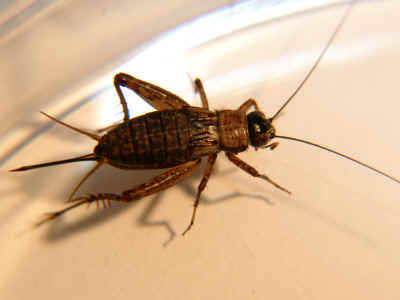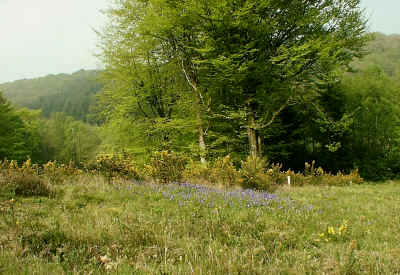Wood-cricket
Nemobius sylvestris
|
A Female Wood-cricket |
| A new population of Nationally Scarce, Wood-crickets,
has been found at the Woodland Education Centre in Offwell, East Devon, England. Wood-crickets are small dark brown crickets. They do not have any hind wings at all and the forewings are reduced. In the male, the forewings cover about half of the abdomen. The female (pictured above) has wings which are just short lateral lobes. Females also have a long ovipositor (this is the long spear-like structure at the back which looks like a sting) which is used for egg-laying. Wood-crickets like warm sunny clearings in broadleaf woodland, or woodland edges where there are deep leaf litter layers. They are often found under oaks, Holly and Bracken. They feed on decaying leaf litter and possibly the associated fungi. This species is classified as Nationally Scarce. It is apparently found in very few places in Britain and has three main centres of distribution. These include Hampshire, the Isle of Wight and South Devon. The largest population of Wood-crickets is found in the New Forest in Hampshire. In Devon, It is found near Chudleigh, as well as around Harpford, near Sidmouth. Wood-crickets have also now been found on the regenerating Heathland Project area at the Woodland Education Centre in Offwell, in East Devon. The Centre is situated approximately 7 miles Northeast of Harpford as the crow flies.
This Wood-cricket population is numerous and has been established on the heathland area for several years. It is undoubtedly a new population. The heathland area at the Centre was originally covered in a failed conifer crop with a dense Rhododendron understory. This type of habitat would have been totally unsuited to the Wood-crickets. The area was cleared in 1993 and has been managed ever since with the aim of restoring a natural heathland habitat to the area. The new Wood-cricket population was first recorded here in 2001. Wood-crickets belong to the same insect group as grasshoppers (Orthoptera). Characteristics of the Orthoptera include straight-veined, leathery- textured forewings, which protect the more delicate, membranous fan-like hindwings. They all have biting mouthparts and often, enlarged hind legs which allow them to jump powerfully. Crickets (Family Gryllidae) have long thread-like antennae. The last portion of each leg, known as the tarsus, consist of 3 segments. Wood-crickets are one of only two native species of crickets in Britain, although there is a total of 6 species altogether. Four of these are species which have been introduced from elsewhere. Although Wood-crickets apparently have such a limited distribution, the places where they do occur contain large populations in relatively safe habitats. Their continued existence in Britain does not therefore appear to be a matter for concern.
|
General information about Wood-crickets from
"Grasshoppers and Allied Insects of Great
Britain and Ireland"
J.A.Marshall and E.C.M. Haes
Harley Books, Essex, England, 1988
Find out more about wildlife at the Woodland Education Centre here

